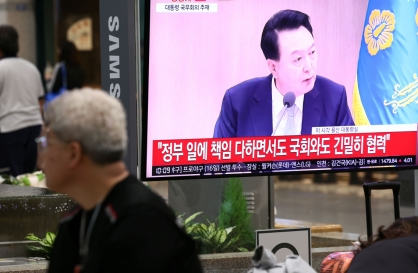[Editorial] Hanoi summit
Trump should get Kim to clarify denuclearization action plans
By Korea HeraldPublished : Feb. 12, 2019 - 17:18
The decision by US President Donald Trump and North Korean leader Kim Jong-un to meet again later this month is brightening prospects of a diplomatic solution for the North’s nuclear threat. It is too early, however, to be optimistic about the outcome of the meeting.
So far, no details -- except the date and location -- have been disclosed, though the two sides have engaged in talks over the Trump-Kim summit to be held in Hanoi, Vietnam, from Feb. 27-28.
Despite three days of talks with senior North Korean officials, the US nuclear envoy who visited Pyongyang last week to fine-tune details of the meeting seems to have left empty-handed.
Stephen Biegun and South Korean officials who met the US diplomat after his visit to Pyongyang strongly indicated that the US and North have -- as Trump said in his State of the Union address -- much work left to be done.
“I would say it was a productive set of discussions over the last few days, and our team engaged on a number of areas of mutual interest, and we’ve agreed to meet again,” Biegun said in Seoul.
“We don’t know where it is going to go, but we are in the midst of a conversation with the North,” he said. The two sides plan to meet again next week to work out deals to be endorsed by Trump and Kim.
Meanwhile, South Korean presidential spokesman Kim Eui-kyeom said he understood that the North and US had “talked openly and fully about their specific positions on what they want” in a very “detailed manner.”
In other words, the talks in Pyongyang fell short of negotiations in which the two parties adopt a “give-and-take” approach; they only sounded out each other on an array of issues.
It is not difficult to guess what issues are keeping US and North Korean officials apart. The US has insisted the North present concrete plans for disarmament, such as a declaration of its nuclear stockpile and facilities, and permit international inspection. The North Korean missile capacity is a major concern for the US.
In return, the US could have offered to take steps to improve bilateral relations with Pyongyang, including the opening of a liaison office and the provision of economic assistance. Trump has said the North would be able to become an “economic powerhouse.”
Last week, the UN Security Council Sanctions Committee on North Korea approved the Federation of Red Cross and Red Crescent Societies’ humanitarian aid to North Korea. This could be a prelude to the US’ increased engagement with the North.
Given the North’s recent demands, such measures are not likely to be enough to induce the North to comply with final, fully verified denuclearization. The list of “corresponding US measures” demanded by the North is quite long.
Atop the list are US security guarantees for the North, which Pyongyang insists should center on the declaration of the end of the Korean War and replacement of the armistice agreement with a permanent peace regime. During his New Year’s address, Kim Jong-un suggested a “multilateral” framework to ensure lasting peace on the Korean Peninsula.
Sanctions relief for the Kim regime is another major concern for the North. In his New Year’s speech, Kim had also expressed his wish to reopen the inter-Korean Kaesong industrial park and resume tours to Kumgangsan, which could become sources of foreign currency for the country.
But the US should not make any premature concessions before substantial disarmament actions are implemented by the North, which had continued to improve its nuclear and missile capacities over the decades despite numerous negotiations and agreements to stop its weapons of mass destruction program.
What South Korea and the world must guard against is the possibility that Trump might end up agreeing to an incomplete denuclearization deal just so he can praise it as a breakthrough and tout it as a major foreign policy accomplishment.
-
Articles by Korea Herald







![[From the Scene] Monks, Buddhists hail return of remains of Buddhas](http://res.heraldm.com/phpwas/restmb_idxmake.php?idx=644&simg=/content/image/2024/04/19/20240419050617_0.jpg&u=20240419175937)








![[From the Scene] Monks, Buddhists hail return of remains of Buddhas](http://res.heraldm.com/phpwas/restmb_idxmake.php?idx=652&simg=/content/image/2024/04/19/20240419050617_0.jpg&u=20240419175937)

![[KH Explains] Hyundai's full hybrid edge to pay off amid slow transition to pure EVs](http://res.heraldm.com/phpwas/restmb_idxmake.php?idx=652&simg=/content/image/2024/04/18/20240418050645_0.jpg&u=20240419100350)

![[Today’s K-pop] Illit drops debut single remix](http://res.heraldm.com/phpwas/restmb_idxmake.php?idx=642&simg=/content/image/2024/04/19/20240419050612_0.jpg&u=)